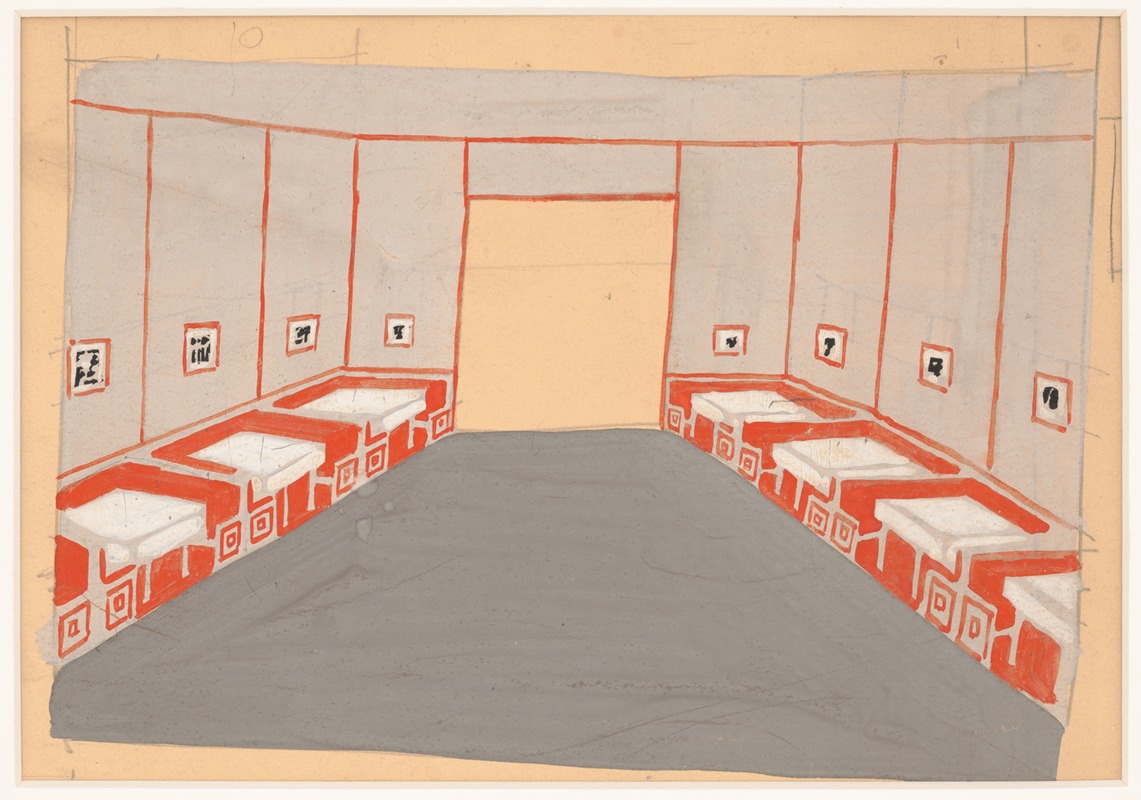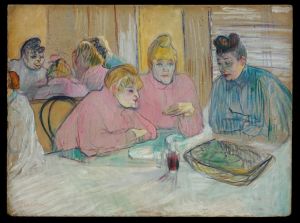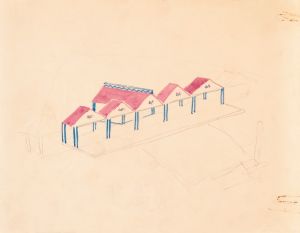
Interior perspective studies for Restaurant Crillon, 15 East 48th Street, New York, NY.] [Study for Le Passage or Pullman Room
A hand-painted replica of Winold Reiss’s masterpiece Interior perspective studies for Restaurant Crillon, 15 East 48th Street, New York, NY.] [Study for Le Passage or Pullman Room, meticulously crafted by professional artists to capture the true essence of the original. Each piece is created with museum-quality canvas and rare mineral pigments, carefully painted by experienced artists with delicate brushstrokes and rich, layered colors to perfectly recreate the texture of the original artwork. Unlike machine-printed reproductions, this hand-painted version brings the painting to life, infused with the artist’s emotions and skill in every stroke. Whether for personal collection or home decoration, it instantly elevates the artistic atmosphere of any space.
Winold Reiss (1886–1953) was a German-American artist and designer known for his contributions to interior design, portraiture, and graphic arts. Among his notable works are his designs for restaurants, hotels, and other public spaces, where he combined vibrant colors, geometric patterns, and modernist aesthetics. One of his projects includes a series of interior perspective studies for the Restaurant Crillon, located at 15 East 48th Street in New York City. These studies, which include designs for spaces such as "Le Passage" or the "Pullman Room," reflect Reiss's innovative approach to interior design during the early 20th century.
The Restaurant Crillon was a prominent dining establishment in New York City, and Reiss's involvement in its design highlights his reputation as a sought-after designer for upscale venues. His work for the restaurant demonstrates his ability to integrate artistic elements into functional spaces, creating interiors that were both visually striking and practical. The studies for the Pullman Room or Le Passage showcase his use of bold colors, intricate patterns, and a modernist sensibility that was ahead of its time.
Reiss's designs often drew inspiration from a variety of sources, including Art Deco, European modernism, and his own background as a trained artist in Germany. His work for the Restaurant Crillon is consistent with his broader body of work, which frequently emphasized harmony between form and function. The interior perspective studies for the restaurant are considered examples of his skill in envisioning and executing cohesive design concepts for public spaces.
While specific details about the exact execution of these designs in the Restaurant Crillon are limited, the surviving studies provide valuable insight into Reiss's creative process and his contributions to interior design during the early 20th century. These works are part of his larger legacy, which includes designs for other notable venues such as the Cincinnati Union Terminal and the Hotel St. George in Brooklyn.
Winold Reiss's work remains influential in the fields of design and art, and his studies for the Restaurant Crillon are an important part of his portfolio, reflecting his ability to merge artistic vision with practical design solutions.






![[Design for mural in unidentified bar or restaurant.] [Study for mural]](/imgs/249261/s/winold-reiss-design-for-mural-in-unidentified-bar-or-restaurant-study-for-mural-93fd9e8e.jpg)
![Design for unidentified bedroom with canopy bed.] [Interior perspective elevation](/imgs/249297/s/winold-reiss-design-for-unidentified-bedroom-with-canopy-bed-interior-perspective-elevation-72bee5bc.jpg)
![Designs and photographs for alterations to St. James Bar Restaurant, W. 181 St. and New York, NY.] [Study of exterior elevation](/imgs/249306/s/winold-reiss-designs-and-photographs-for-alterations-to-st-james-bar-restaurant-w-181-st-and-new-york-ny-study-of-exterior-elevation-c23a0b8e.jpg)
![Designs for Exhibition of Applied Arts Building, New York World’s Fair, 1939.] [Study for front of the building](/imgs/249314/s/winold-reiss-designs-for-exhibition-of-applied-arts-building-new-york-worlds-fair-1939-study-for-front-of-the-building-d3e93639.jpg)

![Designs for unidentified restaurant interior, possibly Elysée restaurant, 1 East 56th St., New York, NY.] [Drawing of restaurant interior elevations](/imgs/249334/s/winold-reiss-designs-for-unidentified-restaurant-interior-possibly-elysee-restaurant-1-east-56th-st-new-york-ny-drawing-of-restaurant-interior-elevations-192740b5.jpg)
![Drawings for proposed decorations of Mike Lyman’s Restaurant, 424 W. Sixth St., Los Angeles, CA.] [Drawing #8, playroom elevation N and O](/imgs/249339/s/winold-reiss-drawings-for-proposed-decorations-of-mike-lymans-restaurant-424-w-sixth-st-los-angeles-ca-drawing-8-playroom-elevation-n-and-o-2e0cd08a.jpg)
![Interior perspective drawings of Hotel Siwanoy, Mount Vernon, NY.] [Interior perspective, unidentified room in pink, vermillion, and black](/imgs/249371/s/winold-reiss-interior-perspective-drawings-of-hotel-siwanoy-mount-vernon-ny-interior-perspective-unidentified-room-in-pink-vermillion-and-black-69402656.jpg)
![Interior perspective studies for Restaurant Crillon, 15 East 48th Street, New York, NY.] [Study for Batik Room or Main Dining Room](/imgs/249377/s/winold-reiss-interior-perspective-studies-for-restaurant-crillon-15-east-48th-street-new-york-ny-study-for-batik-room-or-main-dining-room-f49c2d45.jpg)
![Interior perspective studies for Restaurant Crillon, 15 East 48th Street, New York, NY.] [Study for Winter Garden](/imgs/249379/s/winold-reiss-interior-perspective-studies-for-restaurant-crillon-15-east-48th-street-new-york-ny-study-for-winter-garden-60e13bd3.jpg)
![Design proposals for Puck Theater, New York, NY.] [Interior perspective study.](/imgs/249413/s/winold-reiss-design-proposals-for-puck-theater-new-york-ny-interior-perspective-study-f0303b2a.jpg)
![Design proposals for Puck Theater, New York, NY.] [Interior perspective study.](/imgs/249414/s/winold-reiss-design-proposals-for-puck-theater-new-york-ny-interior-perspective-study-ba0eb061.jpg)
![Designs for theater with black-framed proscenium and boldly colored settings.] [Study for stage light wall decoration, possibly for Caf ̌Crillon](/imgs/249424/s/winold-reiss-designs-for-theater-with-blackframed-proscenium-and-boldly-colored-settings-study-for-stage-light-wall-decoration-possibly-for-caf-crillon-15a7fdab.jpg)